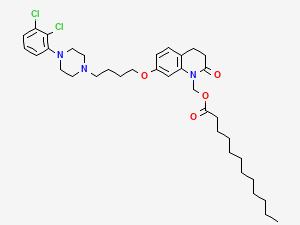Drug information
Aripiprazole Lauroxil
ARISTADA
Small molecule
1) ARISTADA (Aripiprazole Lauroxil) is a long-acting antipsychotic (partial agonist—D2, D3, 5-HT1A, and 5-HT2A receptor) used for the treatment of schizophrenia and related psychotic disorders. 2) The efficacy of ARISTADA is produced by aripiprazole and dehydro-aripiprazole (major metabolite). 3) Pharmacokinetic parameters: t1/2—53.9 days to 57.2 days; Vd—268 L; 4) > 99% bound to albumin 5) The levels of Cmax and AUC values are 2.5% higher for extensive metabolizers of CYP2D6
ARISTADA is approved only in the USA at a price of 1,304 USD for the 441mg dose to 4,107.79 USD for the 1064 mg dose
ARISTADA is approved by US FDA.
Therapeutic area(s)
- Mental health
- Treatment
Administration route
Oral, Intramuscular
Associated long-acting platforms
Inorganic nanoparticles
Use of drug
- Administered by a community health worker
- Administered by a nurse
- Administered by a specialty health worker
- Other : Once monthly, Every 6 weeks and Once every 2 months
Not provided
Dosage
441mg/1.6ml (275.63mg/ml); 662mg/2.4ml (275.83mg/ml); 882mg/3.2ml (275.63mg/ml)
1064 mg single dose as subcutaneous injection
Option 1: Administer one intramuscular injection of ARISTADA INITIO 675 mg (in either the deltoid or gluteal muscle) and one dose of oral aripiprazole 30 mg in conjunction with the first ARISTADA injection. The first ARISTADA injection may be administered on the same day as ARISTADA INITIO or up to 10 days thereafter. See the ARISTADA INITIO prescribing information for additional information regarding administration of ARISTADA INITIO. o Avoid injecting both ARISTADA INITIO and ARISTADA concomitantly into the same deltoid or gluteal muscle. Option 2: Administer 21 consecutive days of oral aripiprazole in conjunction with the first ARISTADA injection.
Not provided
Associated technologies
Not provided
Scale-up and manufacturing prospects
Not provided
Reactor vessel; heating systems; Nitrogen atmosphere setup; Filtration apparatus; Vacuum distillation setup
Manufacturing can be divided into two steps: 1) Formation of Aripiprazole Intermediate (Hydroxymethyl Aripiprazole) using paraformaldehyde, organic solvent (e.g., toluene), and base (e.g., DBU or potassium carbonate). 2) Esterification to form Aripiprazole lauroxil using lauric acid, DCC (activator), DMAP (catalyst), solvent (e.g., dichloromethane)
1. High-Performance Liquid Chromatography (HPLC) 2. Mass Spectrometer
Excipients
Not provided
Not provided
Not provided
Delivery device(s)
No delivery device
Methods for administering aripiprazole
The present invention relates to pharmaceutical compositions comprising a compound of Formula (I) that are useful for the intramuscular delivery of antipsychotic drugs using rapid injection rates.
US8759351B2
Formulation
Alkermes Pharma Ireland Ltd
Not provided
March 13, 2035
Active
Pharmaceutical compositions comprising sorbitan esters
The present invention relates to a pharmaceutical composition comprising sorbitan esters of carboxylic acids that are useful for the delivery of anti-psychotic drugs.
US20240131024A1
Formulation
Alkermes Pharma Ireland Ltd
Not provided
Not provided
Pending
Publications
Efficacy and Safety of a 2-Month Formulation of Aripiprazole Lauroxil With 1-Day Initiation in Patients Hospitalized for Acute Schizophrenia Transitioned to Outpatient Care: Phase 3, Randomized, Double-Blind, Active-Control ALPINE Study.
Weiden, P. J., Claxton, A., Kunovac, J., Walling, D. P., Du, Y., Yao, B., Yagoda, S., Bidollari, I., Keane, E., & Cash, E. (2020). The Journal of clinical psychiatry, 81(3), 19m13207.
Objective: Evaluate efficacy and safety of a 2-month formulation of aripiprazole lauroxil (AL) with 1-day initiation during hospitalization for acute exacerbation of schizophrenia followed by transition to outpatient care.
Methods: The phase 3b double-blind Aripiprazole Lauroxil and Paliperidone palmitate: INitiation Effectiveness (ALPINE) study was conducted from November 2017 to March 2019. Adults with acute schizophrenia according to DSM-5 criteria were randomized (1:1) to AL (AL NanoCrystal Dispersion + oral aripiprazole 30 mg, day 1; AL 1,064 mg, day 8 and every 8 weeks [q8wk]) or paliperidone palmitate (PP 234 mg, day 1; PP 156 mg, day 8 and then q4wk) for 25 weeks. Patients remained hospitalized ≥ 2 weeks after randomization per protocol. Primary endpoint was within-group change in Positive and Negative Syndrome Scale total score (PANSST) from baseline to week 4. Secondary analyses included within- and between-group changes from baseline at various time points. Adverse events (AEs) and laboratory data were monitored.
Results: A total of 200 patients were randomized (AL, n = 99; PP, n = 101); 56.6% and 42.6%, respectively, completed the study. For AL, the mean baseline PANSST was 94.1; scores were significantly reduced from baseline at week 4 (-17.4; P < .001) and were also reduced at weeks 9 (-19.8) and 25 (-23.3). With PP, PANSST also improved significantly from baseline (94.6) at week 4 (-20.1; P < .001) and also improved at weeks 9 (-22.5) and 25 (-21.7). The 3 most common AEs over 25 weeks in the AL group were injection site pain (17.2%), increased weight (9.1%), and akathisia (9.1%). The same AEs were the most common in the PP group (injection site pain [24.8%], increased weight [16.8%], and akathisia [10.9%]).
Conclusions: AL and PP were efficacious and well-tolerated for initiating treatment of schizophrenia in the hospital and continuing outpatient treatment.
Best Practices for Aripiprazole Lauroxil Administration: From Formulation Development to Injection Technique.
Farwick, S., Hickey, M. B., Jacobs, G., Faldu, S. P., Vandiver, J., & Weiden, P. J. (2019).
Journal of psychiatric practice, 25(2), 82–90. https://doi.org/10.1097/PRA.0000000000000376
Long-acting injectable (LAI) antipsychotics are an important treatment option for patients with schizophrenia. Advances and variability in formulation technology have provided several LAI antipsychotic treatment options for schizophrenia, with a wide range of doses and dose intervals. However, clinical reviews of LAIs have not focused on formulation development despite its clinical relevance to injection safety and technique. This article reviews the relationship between formulation technology and clinical practices for LAIs, with a focus on aripiprazole lauroxil, a long-acting atypical antipsychotic indicated for the treatment of schizophrenia. The formulation developed for aripiprazole lauroxil is an aqueous-based suspension suitable for use as a prefilled syringe that, after injection, will release aripiprazole slowly into the plasma. The clinical relationship between the aripiprazole lauroxil formulation and proper injection techniques is explained, including why tapping and shaking the syringe to resuspend the drug particles and rapid injection speed are key steps for best injection practices for this formulation.
Aripiprazole Lauroxil Compared with Paliperidone Palmitate in Patients with Schizophrenia: An Indirect Treatment Comparison.
Cameron, C., Zummo, J., Desai, D. N., Drake, C., Hutton, B., Kotb, A., & Weiden, P. J. (2017).
Value in health : the journal of the International Society for Pharmacoeconomics and Outcomes Research, 20(7), 876–885. https://doi.org/10.1016/j.jval.2017.03.010
Background: Aripiprazole lauroxil (AL) is a long-acting injectable atypical antipsychotic recently approved for treatment of schizophrenia on the basis of a large-scale trial of two doses of AL versus placebo. There are no direct-comparison studies with paliperidone palmitate (PP; long-acting antipsychotic used most often in acute settings) for the acute psychotic episode.
Objectives: To indirectly compare efficacy and safety of the pivotal AL study with all PP studies meeting indirect comparison criteria.
Methods: Systematic searches of MEDLINE, Embase, Cochrane CENTRAL, PsycINFO, ClinicalTrials.gov, International Clinical Trials Registry Platform, and gray literature were performed to identify randomized controlled trials of PP with similar designs to the AL trial. Bayesian network meta-analysis compared treatments with respect to symptom response and tolerability issues including weight gain, akathisia, parkinsonism, and likelihood of treatment-emergent adverse events.
Results: Three appropriate PP studies were identified for indirect comparison. Both doses of AL (441 mg and 882 mg monthly) were used and compared with two efficacious doses of PP (156 mg and 234 mg monthly). All four active-treatment conditions were associated with comparable reductions in acute symptoms (Positive and Negative Syndrome Scale) versus placebo and were of similar magnitude (range of mean difference -8.12 to -12.01, with overlapping 95% credible intervals). Between-group comparisons of active-treatment arms were associated with summary estimates of magnitude near 0. No clinically meaningful differences in selected safety or tolerability parameter incidence were found between active treatments.
Conclusions: These results suggest that both AL and PP are effective for treatment of adults experiencing acute exacerbation of schizophrenia.
Keywords: aripiprazole lauroxil; indirect comparison; paliperidone palmitate; schizophrenia.
Additional documents
No documents were uploaded
Useful links
There are no additional links
Collaborate for development
Consider on a case by case basis, collaborating on developing long acting products with potential significant public health impact, especially for low- and middle-income countries (LMICs), utilising the referred to long-acting technology
Share technical information for match-making assessment
Provide necessary technical information to a potential partner, under confidentiality agreement, to enable preliminary assessment of whether specific medicines of public health importance in LMICs might be compatible with the referred to long-acting technology to achieve a public health benefit
Work with MPP to expand access in LMICs
In the event that a product using the referred to long-acting technology is successfully developed, the technology IP holder(s) will work with the Medicines Patent Pool towards putting in place the most appropriate strategy for timely and affordable access in low and middle-income countries, including through licensing

